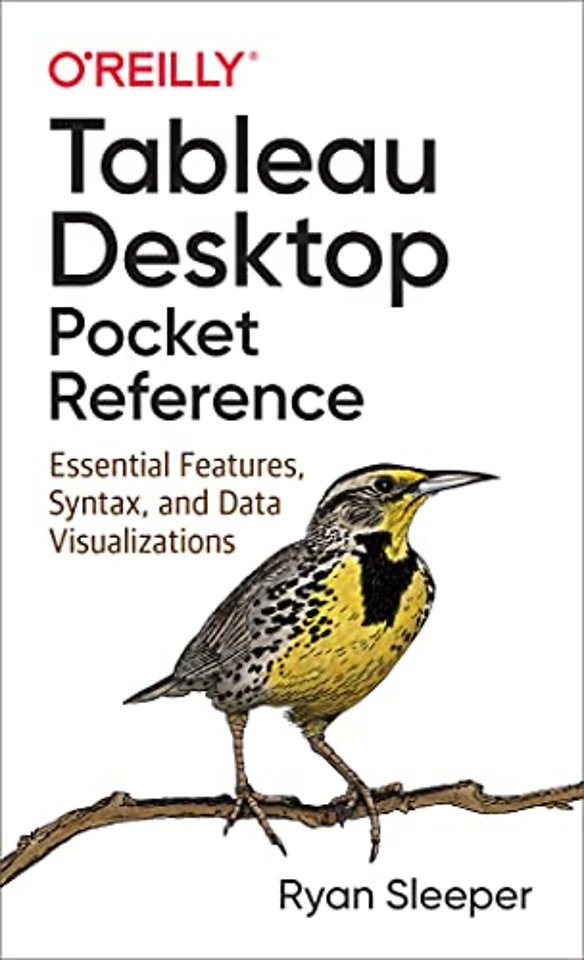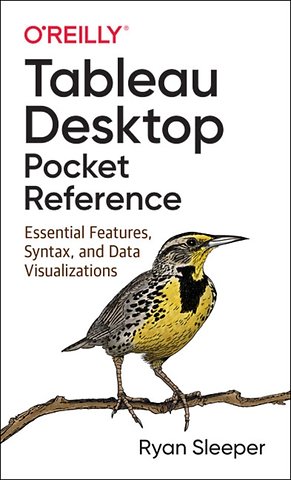


As Director of Data Visualization & Analysis at Evolytics, my specialty is helping businesses understand their data through visualization – primarily using Tableau.
Meer over Ryan SleeperTableau Desktop Pocket Reference
Essential Features, Syntax, and Data Visualizations
Paperback Engels 2021 1e druk 9781492093480Samenvatting
In a crowded field of data visualization and analytics tools, Tableau Desktop has emerged as the clear leader. This is partly due to its ease of use, but once you dive into Tableau's extensive feature set, you'll understand just how powerful and flexible this software can be for your business or organization.
With this handy pocket reference, author Ryan Sleeper (Innovative Tableau) shows you how to translate the vast amounts of data into useful information. Tableau has done an amazing job of making valuable insights accessible to analysts and executives who would otherwise need to rely on IT. This book quickly guides you through Tableau Desktop's learning curve.
You'll learn:
- How to shape data for use with Tableau Desktop
- How to create the most effective chart types
- Core concepts including discrete versus continuous
- Must-know technical features including filters, parameters, and sets
- Key syntax for creating the most useful analyses
- How to bring it all together with dashboards
And more!
Specificaties
Lezersrecensies
Inhoudsopgave
Conventions Used in This Book
Playfair Data TV
O’Reilly Online Learning
How to Contact Us
Acknowledgments
1. Tableau’s Product Ecosystem
Tableau Products
Tableau License Model
Tableau Version Updates
2. Shaping Data
Common Data Layout
Ideal Data Layout
How to Reshape Data
3. Connecting to Data
Data Models
Live Data Connections Versus Data Extracts
Data Source Versus Extract Filters
Data Types
4. Tableau Terminology
Data Pane
Fields
Shelves
Marks Card
Columns, Rows, and Chart Types
5. Dimension Versus Measure
Using Measures
Using Dimensions
Making Classifications
6. Discrete Versus Continuous
Visualizing Discrete and Continuous Options
Changing Discrete and Continuous Options
7. How to Make a Bar Chart
Creating a Bar Chart
Introducing Aggregation in Tableau
Combining Measures and Dimensions to Glean Insight
8. How to Make a Line Graph
Tableau Line Graph Defaults
Using the Show Me Feature
Adding Context to a Line Graph by Encoding Marks
Formatting Tips for Line Graphs
9. How to Make a Scatter Plot
Visualization Level of Detail
Getting Started with the Analytics Pane
Closing Thoughts on Chart Types
10. Filters
Types of Filters
Options for Scaling Filters
Understanding Tableau’s Filter Order of Operations
Data Source and Extract Filters
11. Calculated Fields
Basic Calculated Fields
Aggregate Calculated Fields
Row-Level Calculated Fields
Table Calculations
Level of Detail Calculations
12. Parameters
How to Make a Parameter
How to Use Dynamic Parameters
Popular Use Cases
Using a String for Dimension Member Highlighting and/or Filtering
Using a Float for Scenario Playing
Using a Dynamic Parameter for Date Filtering
13. Sets
How to Create Sets
Practical Use Cases
Sets as a Filter
Sets as a Dimension
Sets within Calculated Fields
Sets as a Highlighter
14. Dashboards and Distribution
The Dashboard Pane
Choosing the Layout and Size of a Dashboard
Dashboard Sheets and Objects
Tiled, Floating, and Hybrid Objects
The Layout Pane
Dashboard Actions
Distributing Dashboards
Tableau Server or Tableau Online
Tableau Public
Tableau Packaged Workbook
PowerPoint
Images
Conclusion
Index
Anderen die dit boek kochten, kochten ook
Rubrieken
- advisering
- algemeen management
- coaching en trainen
- communicatie en media
- economie
- financieel management
- inkoop en logistiek
- internet en social media
- it-management / ict
- juridisch
- leiderschap
- marketing
- mens en maatschappij
- non-profit
- ondernemen
- organisatiekunde
- personal finance
- personeelsmanagement
- persoonlijke effectiviteit
- projectmanagement
- psychologie
- reclame en verkoop
- strategisch management
- verandermanagement
- werk en loopbaan





